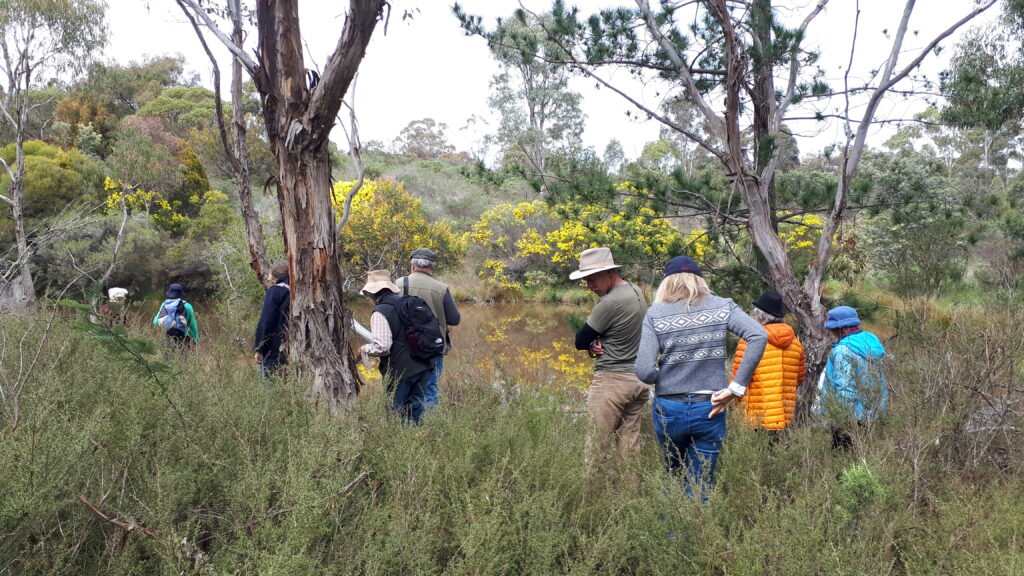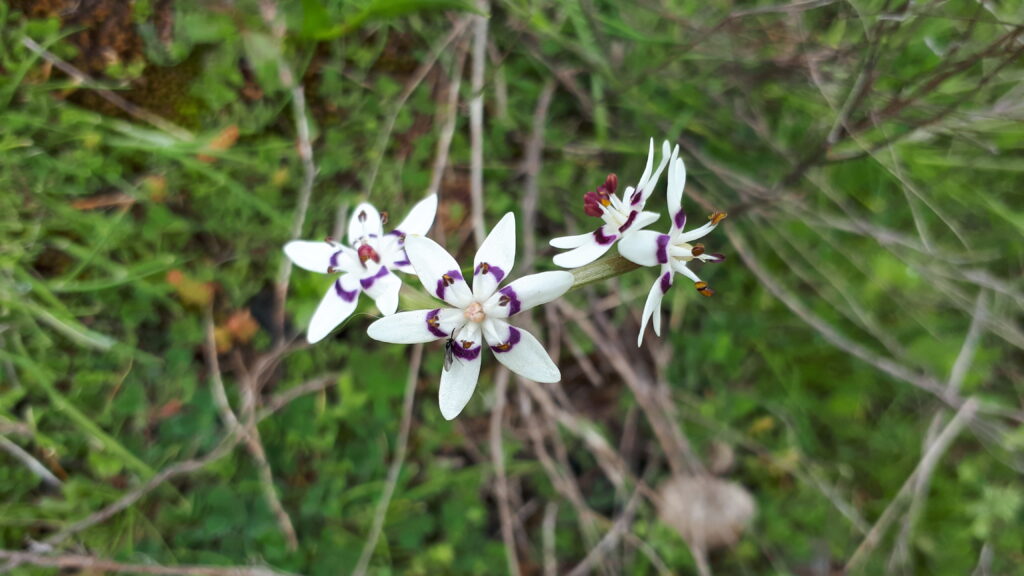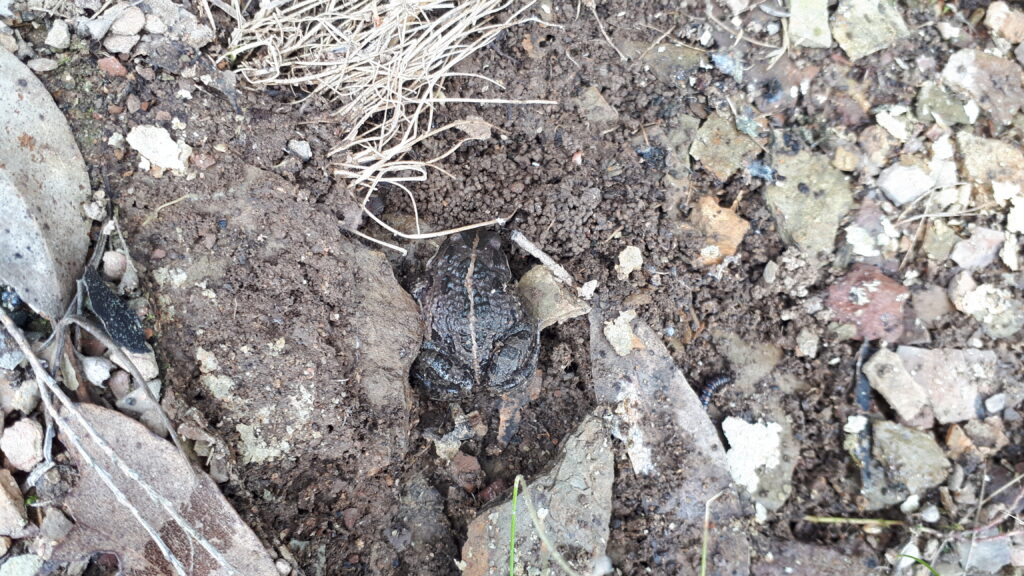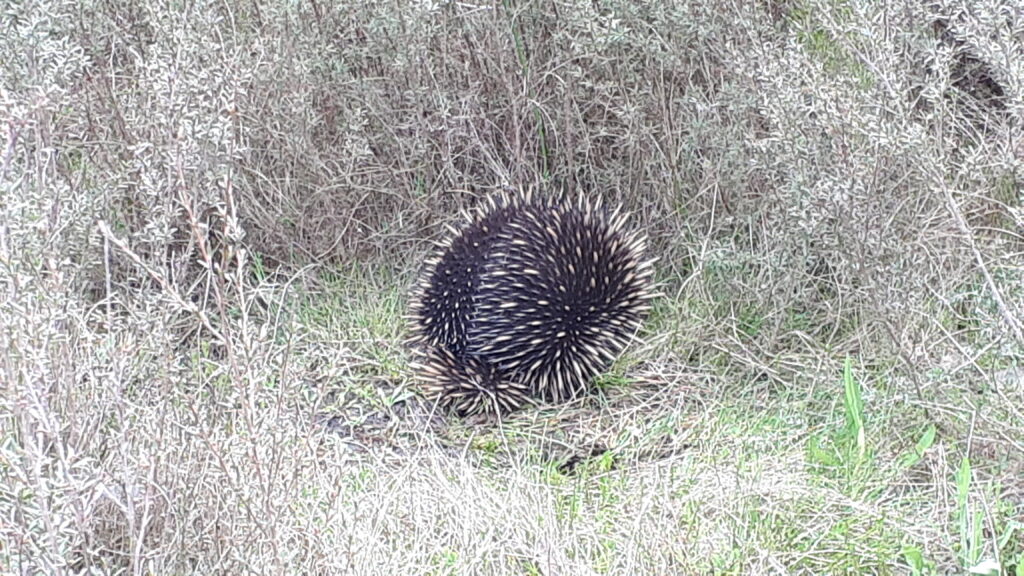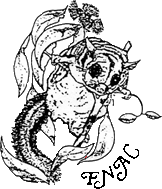Jo very kindly invited us to explore her rural property at Wamboin, which she bought in 1981, then subsequently built a house a few years later and has planted a substantial number of native plants since.
After a congenial cup of tea and biscuits she led us through meandering tracks through her property. But even before this the house itself held a fascination with the collection of geological rocks on the kitchen window sill and I’ve never been in a house that had a microscope and seed collection for examination on the kitchen counter.
Some of the plants on the property are original, however she has planted quite a few trees and shrubs that she encountered on her various trips around Australia so not all are native to this region.
She first led us to a small pond and even from the house we could hear the chorus of frogs that live in this and the larger pond further up the property, through which a small creek flows, though after all the recent rain, the ground was quite wet in a number of places.
Among the flowering herbaceous plants were Hoary Sunrays, Billy Buttons and Ranunculas. Rosettes of Greenhood orchids were not yet showing signs of flower buds and the wetter areas had a number of sundews, yet to flower and of course mosses and lichens, some of which were flowering. Early Nancys were everywhere.
There were a number of Acacia species in flower as well as a patch of Comesperma volubile.
Overturning rocks looking for Scorpions we uncovered two species of frogs: a Spotted Grass Frog and a Smooth Toadlet.
We did also find a number of Black Rock Scorpions as well as a couple of large Centipedes.
However, we shouldn’t forget the invertebrates. One rock revealed a very interesting large Leopard Slug.
We didn’t see many insects apart from a few Eucalyptus leaf beetles and numerous tiny grasshoppers that seemed to be everywhere.
While not as easily photographed, we heard or saw Satin Bowerbirds, Currawongs, Eastern Spinebills and Black-faced Cuckoo Shrike among the bird life.
Back at the house for a very late lunch on the back steps, we had a few kangaroos pass close by to go and rest on the front lawn waiting to be fed. One had a young joey in her pouch.
In all we had a very enjoyable outing and thank Jo for letting us explore her lovely property and for her hospitality with cups of tea and biscuits.
– Alison Milton
Reflections on and from our visit to Jo’s place near Wamboin
I write this after eight hours of teamwork where volunteers presented 6000 native plants for sale to local enthusiasts. How many of the buyers will be creating, restoring and maintaining wildlife friendly habitat in the spaces in and around their homes?
Jo bought her property in the 1980s allowing the sclerophyll forest, the shaley woodland, creek lines and open native grassland to be a continuing haven, a home to the thousands of species whose ancestors stretch back millions of years.
Jo has protected the place from invasive species like those we could see on public land and adjacent properties as we drove towards Wamboin from our suburbs. She studied and propagated her local species for others to enjoy and, like us on 4 October, has shown hundreds around the block that has views west towards distant Mount Majura.
Memories
Jo cautiously lifted and exactly replaced shaley stones revealing hidden invertebrate treasures including ants’ colonies, spiders, beetles, centipedes and scorpions and at least two frog species very distant from the creeks and dam.
A lone Waxlip Orchid showed that floral displays in woodlands nearer the suburbs are resulting from warmth whereas Jo’s property is still recovering from winter.
There were treats of electric-blue highlighted by the sun on multiple Comesperma volubile plants scrambling over shrubs growing on the ridge line.
Sedges have edges, rushes have round (leaves) a helpful phrase from Morgan.
Multitudes of frogs calling near the dam, along the creek or wherever the grasses were damp enough.
he moments when we stood still listening to a serenade from a Grey Shrike-thrush silhouetted against the sky high on a Eucalypt’s dead branches.
Two Cunninghams Skinks basked in the intermittent sunshine on a large, long-fallen tree trunk. They could rapidly retreat into the timber’s crevices and hollows but their camouflage protected them from predators.
Habitateers
I think of those with light footprints who respectfully live in and care for other species habitats as habitateers. They are volunteers (or volunteer with their money) who, with wonder, love, kinship, knowledge, and curiosity, take time to observe, record and share their experiences while regenerating the natural health of places drastically changed since colonisation.
Feelings for nature, for country and being caringly regenerative, deeply resonate in our souls in the spirit of being alive.
The rewards of being connected to a place, belonging within and being part of a community, making a difference for other species, sharing delight in the beauty and diversity of the natural world are powerful drivers of volunteers’ enthusiasm and persistence.
Whether on a bush block or in suburbia, how many of us are there, living lightly and non-exploitatively on Country respectfully immersed in other species habitats?
We read the landscape, content to make the most of what we have without adversely affecting others. How many of us have our own personal or official covenants with nature to take only what we need as First Nations have done the world over?
Thank you Jo for hosting and leading our explorations and remembering Ian Anderson, an exemplary habitateer and Field Natter.
– Rosemary Blemings
